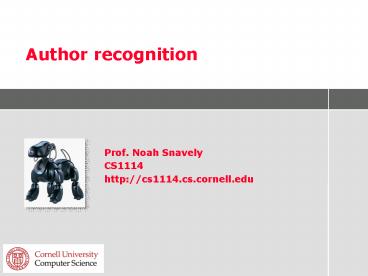Author recognition - PowerPoint PPT Presentation
1 / 20
Title:
Author recognition
Description:
Author recognition Prof. Noah Snavely CS1114 http://cs1114.cs.cornell.edu – PowerPoint PPT presentation
Number of Views:73
Avg rating:3.0/5.0
Title: Author recognition
1
Author recognition
Prof. Noah Snavely CS1114 http//cs1114.cs.cornell
.edu
2
Administrivia
- Quiz 5 this Thursday, 4/23
- Focus on Markov chains
- A6 released, due on Friday
- There will be demo sessions
- You will also turn in your code this time
- Prelim 3 next Thursday, 4/30 (last lecture)
- Will be comprehensive, but focus on most recent
material
3
Administrivia
- Final projects
- Due on Friday, May 8 (one big demo session)
- Other CS faculty may come by
- The proposals look great!
4
Whats the difference...
- between
- A is a cell array
- A(1)
- and
- A1
- ?
5
Markov chains
- Example Springtime in Ithaca
- We can represent this as a kind of graph
- (N Nice, S Snowy, R Rainy)
Transition probabilities
6
Author recognition
- Simple problem
- Given two Markov chains, say Austen (A) and
Dickens (D), and a string s (with n words), how
do we decide whether A or D wrote s? - Idea For both A and D, compute the probability
that a random walk of length n generates s
7
Probability of a sequence
- What is the probability of a given n-word
sequence s? - s s1 s2 s3 sn
- Probability of generating s the product of
transition probabilities
Probability that a sequence starts with s1
Transition probabilities
(well ignore this for now)
8
Likelihood
- Compute this probability for A and D
Jane Austen wrote s
likelihood of A
Charles Dickens wrote s
likelihood of D
???
9
Problems with likelihood
- Most strings of text (of significant length) have
probability zero - Why?
- Even if its not zero, its probably extremely
small - Whats 0.01 0.01 0.01 (x200) 0.01?
- According to Matlab, zero
- How can we fix these problems?
10
a
2/3 1/3
1/3 1/3 1/3
1
1
1
1
1
1
1
1
1
1
dog
is
mans
best
friend
its
eat
world
out
there
.
a
.
is
its
dog
eat
out
best
there
friend
mans
world
Pr( is dog mans best friend) 0
11
Bigger example
it
0.004 0.17 0.005 0.002 0.002
0.004 0.06 0.004 0.001
0.003 0.002 0.002
0.26
0.017 0.23 0.001
0.04 0.04
0.47
0.5
0.025 0.025
0.036
was
the
best
of
times
worst
birthday
far
better
it
of
far
the
was
best
13253 cols
times
worst
better
birthday
13253 rows
12
Handling zeroes
- We dont want to give every string with a new
word / transition zero probability - Several possibilities to consider
- Transition from a known word to an new word
- Transition from a new word to a new word
- Transition from a new word to a known word
- Transition from a known word to a known word
(unseen transition)
13
Handling zeroes
e
Test text big bike
e
The probability of generating this string with
this Markov chain is zero Idea well add a
small probability e of any unobserved
transition (Reminiscent of PageRank)
0.01
0.05
e
bike
e
e
e
Trained Markov chain (in part)
14
Handling zeroes
Test text big elephant
We didnt see elephant in the training
text What should be the probability of a
transition from big ? elephant?
?
elephant
15
Handling zeroes
Test text elephant helicopter
We didnt see elephant or helicopter in the
training text What should be the probability of
a transition from elephant ? helicopter?
helicopter
?
16
Handling zeroes
Test text helicopter bike
We didnt see helicopter in the training
text What should be the probability of a
transition from helicopter ? bike?
?
helicopter
?
17
Handling very low probabilities
- Theres a smallest (positive) number that Matlab
can store (why?) - gtgt realmin
- ans
- 2.2251e-308
- Pretty small (the size of an electron is 10-15 m)
- The probability of generating a given long string
can easily be less than this (but still gt 0)
18
Handling very low probabilities
- 0.01 0.01 0.01 (200 times) 0.01 0
- How can we fix this?
- Well compute the log of the probability instead
- log(0.01 0.01 0.01 (200 times) 0.01)
- log(0.01) log(0.01) (200 times)
log(0.01) - -2 - 2 - (200 times) - 2
- -400
19
Handling very low probabilities
- log(0.01 0.01 0.01 (x200) 0.01)
- log(0.01) log(0.01) (x200)
log(0.01) - -2 - 2 - (x200) - 2
- -400
- I.e., were compute the exponent of the
probability (roughly speaking) - If log(P) gt log(Q), then P gt Q
20
Testing authorship
- In A6, youll train Markov chains for several
authors - Given several new test sequences, youll guess
who wrote which sequence - By finding the chain with the highest
log-likelihood - Youre free to extend this in any way you can
think of (treat periods and other punctuation
differently, higher-order Markov models, etc) - The best performing code (on our tests) will get
two points of extra credit































